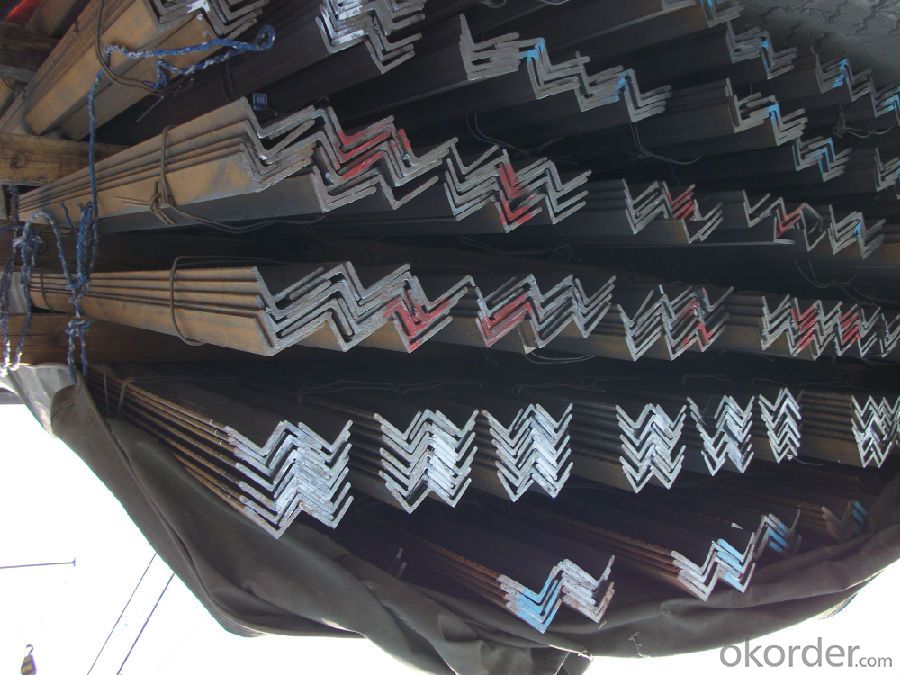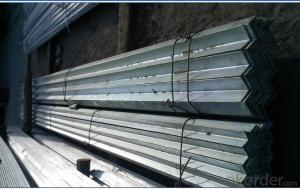Angle Steel with High Quality for Construction
- Loading Port:
- Tianjin
- Payment Terms:
- TT OR LC
- Min Order Qty:
- 25 m.t.
- Supply Capability:
- 20000 m.t./month
OKorder Service Pledge
OKorder Financial Service
You Might Also Like
Item specifice
Product Description:
OKorder is offering Angle Steel with High Quality for Construction at great prices with worldwide shipping. Our supplier is a world-class manufacturer of steel, with our products utilized the world over. OKorder annually supplies products to European, North American and Asian markets. We provide quotations within 24 hours of receiving an inquiry and guarantee competitive prices.
Product Applications:
Angle Steel with High Quality for Construction are ideal for structural applications and are widely used in the construction of buildings and bridges, and the manufacturing, petrochemical, and transportation industries.
Product Advantages:
OKorder's Angle Steel with High Quality for Construction are durable, strong, and resist corrosion.
Main Product Features:
· Premium quality
· Prompt delivery & seaworthy packing (30 days after receiving deposit)
· Corrosion resistance
· Can be recycled and reused
· Mill test certification
· Professional Service
· Competitive pricing
Packaging & Delivery of Angle Steel with High Quality for Construction:
Packaging Detail: products are packed in bundle and then shipped by container or bulk vessel, deformed bar is usually naked strapping delivery, when storing, please pay attention to moisture proof. The performance of rust will produce adverse effect.
Each bundle weight: 2-3MT, or as required
Payment term: TT or L/C
Delivery Detail: within 45 days after received advanced payment or LC.
Label: to be specified by customer, generally, each bundle has 1-2 labels
Trade terms: FOB, CFR, CIF
Images:


- Q:Can steel angles be used in the construction of pedestrian bridges?
- Indeed, the utilization of steel angles is feasible in the construction of pedestrian bridges. Owing to their robustness and longevity, steel angles are widely employed in construction. They serve the purpose of offering structural support and stability to pedestrian bridges, while also enabling the creation of frames, beams, and trusses. The adaptability in design and construction is facilitated by the ease of welding or bolting steel angles together. Moreover, steel angles can be galvanized or coated, amplifying their resistance to corrosion and rendering them suitable for outdoor applications like pedestrian bridges. All in all, steel angles emerge as a versatile and dependable option for the construction of pedestrian bridges.
- Q:Are steel angles suitable for conveyor systems?
- Yes, steel angles are suitable for conveyor systems. They provide strength, stability, and durability, making them an ideal choice for supporting and guiding conveyor belts. Steel angles can withstand heavy loads, resist corrosion, and offer flexibility in designing conveyor structures.
- Q:How do you calculate the moment of inertia of a steel angle?
- In order to determine the moment of inertia of a steel angle, it is necessary to have knowledge of the angle's dimensions and shape. The moment of inertia is a measurement of an object's resistance to rotational changes and is crucial in the fields of engineering and physics. The moment of inertia, designated as I, can be computed using the following equation: I = (b * h^3) / 12 In this equation: - I represents the moment of inertia - b corresponds to the base width of the steel angle - h denotes the height or leg length of the steel angle This equation assumes that the steel angle is a uniform and solid entity. If the steel angle possesses varying dimensions or contains holes, the calculation becomes more intricate and may necessitate additional formulas or numerical methods. It should be emphasized that the moment of inertia is dependent on the axis of rotation. The aforementioned equation calculates the moment of inertia with respect to the centroidal axis, which is the axis that passes through the angle's center of mass. If the moment of inertia needs to be determined for a different axis, the parallel axis theorem or other advanced techniques may need to be employed. In practical applications, it is often beneficial to consult engineering handbooks or reference materials specifically tailored to steel angles. These resources may offer more comprehensive formulas or tables that consider specific design characteristics and dimensions.
- Q:Can steel angles be used in the construction of parking garages?
- Yes, steel angles can be used in the construction of parking garages. Steel angles are commonly used in construction for their strength, durability, and versatility. They can be used in various structural applications, including the construction of parking garages. Steel angles can be used to provide support and reinforcement for structural elements such as beams and columns, as well as for framing and bracing. They are often used to create the framework for parking garage floors and walls, providing stability and strength to the structure. Additionally, steel angles can be easily fabricated and customized to meet the specific design and engineering requirements of a parking garage. Overall, steel angles are a popular choice in the construction of parking garages due to their ability to withstand heavy loads, resist corrosion, and provide long-lasting performance.
- Q:How are steel angles protected against impact damage?
- Steel angles can be protected against impact damage through various means, such as installing protective barriers or guards, using impact-resistant coatings, or incorporating shock-absorbing materials.
- Q:Can steel angles be used for reinforcement in concrete structures?
- Yes, steel angles can be used for reinforcement in concrete structures. They are commonly used to provide additional strength and stability to concrete elements such as beams, columns, and slabs. Steel angles are often incorporated as reinforcement to resist bending, shear, and torsional forces, enhancing the overall structural integrity of the concrete elements.
- Q:Can steel angles be used in bridges?
- Yes, steel angles can be used in bridges. Steel angles are commonly used in bridge construction due to their versatility and structural strength. They can be used to form the main framework of the bridge, provide support and reinforcement, and connect different structural elements together. Steel angles are particularly useful for bridge construction as they can be easily welded or bolted to other steel components, enabling efficient and durable construction. Additionally, steel angles are highly resistant to corrosion, making them suitable for bridges exposed to harsh environmental conditions. Overall, steel angles are a reliable and cost-effective choice for incorporating into bridge designs.
- Q:How do steel angles perform under impact or dynamic loading conditions?
- Steel angles are known for their excellent performance under impact or dynamic loading conditions. Their shape provides structural stability and resistance to bending, making them highly effective in withstanding sudden forces and vibrations. The high strength of steel angles allows them to absorb energy and distribute it evenly, reducing the risk of deformation or failure. Overall, steel angles are reliable and dependable in demanding situations with impact or dynamic loading.
- Q:Are steel angles suitable for supporting rooftop equipment?
- Yes, steel angles are suitable for supporting rooftop equipment. Steel angles are commonly used in construction and engineering projects for their strength and durability. They provide a stable and secure support structure for rooftop equipment, such as HVAC units, solar panels, and communication antennas. Steel angles can be easily fabricated and installed to meet specific load requirements, making them an ideal choice for supporting heavy equipment on rooftops. Additionally, their corrosion resistance properties ensure long-term performance and minimal maintenance needs.
- Q:What is the typical thickness tolerance for steel angles?
- The thickness tolerance for steel angles may vary based on manufacturing standards and requirements. Typically, steel angles have a thickness tolerance ranging from +/- 0.005 to 0.010 inches (0.13 to 0.25 mm). Nevertheless, it is crucial to consider that the tolerance can be affected by the size and dimensions of the angle. Larger and thicker steel angles may have slightly more lenient tolerances compared to smaller and thinner angles. To determine the precise thickness tolerance for a specific steel angle, it is advisable to refer to the appropriate industry standards or specifications.
1. Manufacturer Overview |
|
|---|---|
| Location | |
| Year Established | |
| Annual Output Value | |
| Main Markets | |
| Company Certifications | |
2. Manufacturer Certificates |
|
|---|---|
| a) Certification Name | |
| Range | |
| Reference | |
| Validity Period | |
3. Manufacturer Capability |
|
|---|---|
| a)Trade Capacity | |
| Nearest Port | |
| Export Percentage | |
| No.of Employees in Trade Department | |
| Language Spoken: | |
| b)Factory Information | |
| Factory Size: | |
| No. of Production Lines | |
| Contract Manufacturing | |
| Product Price Range | |
Send your message to us
Angle Steel with High Quality for Construction
- Loading Port:
- Tianjin
- Payment Terms:
- TT OR LC
- Min Order Qty:
- 25 m.t.
- Supply Capability:
- 20000 m.t./month
OKorder Service Pledge
OKorder Financial Service
Similar products
New products
Hot products
Related keywords


























